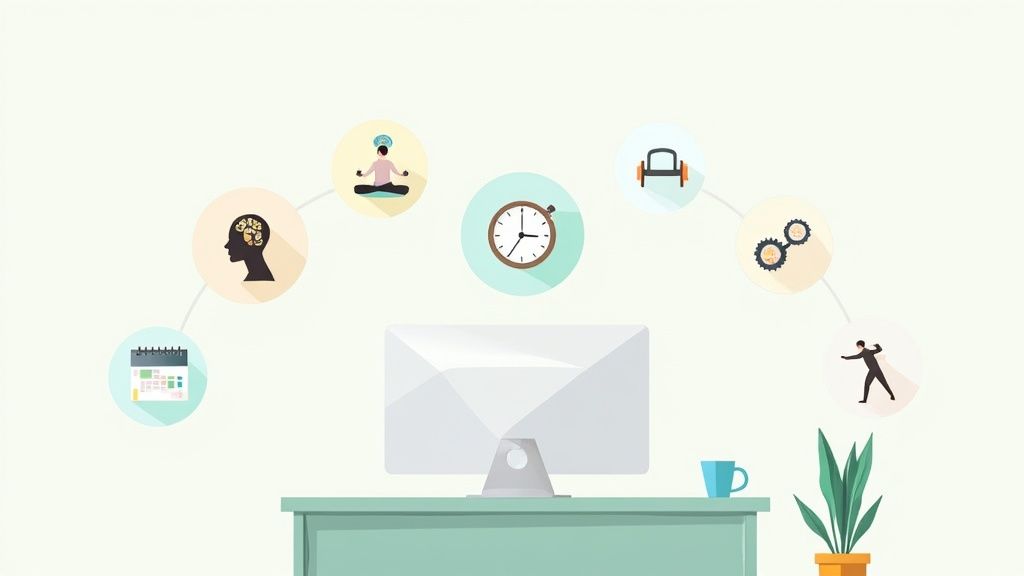
8 Essential Workplace Stress Management Techniques for 2025
In today’s demanding professional landscape, workplace stress often feels like an unavoidable part of the job. Looming deadlines, high-stakes projects, and an ‘always-on’ work culture can leave even the most resilient individuals feeling overwhelmed and heading toward burnout. The goal is not to eliminate stress entirely, a near-impossible task, but to build a robust toolkit of effective strategies to manage it proactively.
This guide provides a comprehensive roundup of eight essential workplace stress management techniques. We move beyond generic advice to offer actionable, evidence-based methods you can implement starting today. You will learn practical approaches, from mindfulness practices adapted for the modern office to cognitive strategies that help rewire your response to pressure. Each technique is designed to empower you to regain control, improve focus, and cultivate a healthier, more sustainable work life. By mastering these skills, you can transform your relationship with professional pressure and maintain your well-being. Let’s explore the specific steps you can take to reclaim your calm and thrive in your career.
1. Mindfulness Meditation
Mindfulness meditation is a powerful mental training practice that teaches you to slow down racing thoughts, let go of negativity, and calm both your mind and body. It involves focusing your attention on the present moment, often by concentrating on your breath or bodily sensations, without judgment. As a workplace stress management technique, it helps you detach from the pressures of deadlines, difficult colleagues, or a demanding workload, allowing for improved emotional regulation and a clearer perspective.
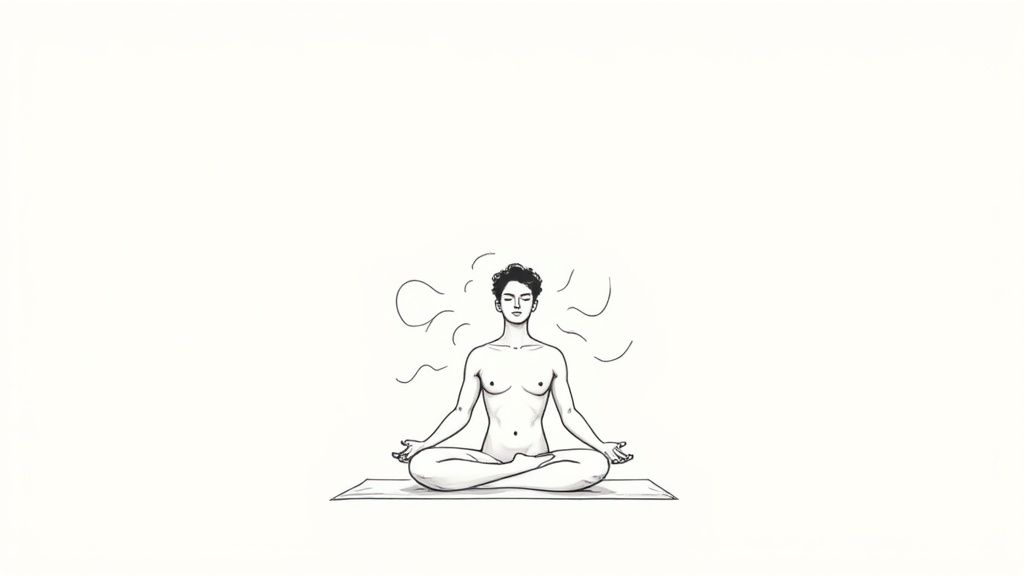
This isn’t just a trend; it’s a data-backed strategy. Companies like Google, with its “Search Inside Yourself” program, and Aetna have seen significant results. Aetna reported an average productivity gain of $3,000 per employee after implementing its mindfulness program, highlighting the direct business impact of reduced stress.
How to Implement Mindfulness at Work
Getting started with mindfulness doesn’t require a silent retreat or hours of practice. You can integrate it directly into your workday with small, manageable steps.
- Start Small: Begin with just 3-5 minutes a day. Use your lunch break or the few minutes before starting your computer to sit quietly and focus on your breathing. Consistency is more important than duration.
- Leverage Technology: Use guided meditation apps like Calm or Headspace. These platforms offer specific sessions tailored for work-related stress, anxiety, and focus, making the practice accessible for beginners.
- Create a Quiet Zone: Find a corner in the office, a quiet conference room, or even a peaceful outdoor spot where you can practice without interruption. Having a dedicated space makes it easier to build the habit.
- Practice Mindful Moments: When you feel overwhelmed in a meeting or by an email, take 30 seconds to focus entirely on your breath. Inhale deeply, then exhale slowly. This simple act can reset your nervous system and prevent a reactive response.
- Perform a Body Scan: After sitting at your desk for long periods, take a moment to mentally scan your body from head to toe. Notice any areas of tension, like your shoulders or jaw, and consciously release them. This helps alleviate the physical manifestations of workplace stress.
2. Deep Breathing Techniques
Deep breathing techniques are simple yet profound exercises that directly influence your body’s stress response. By consciously controlling your breath, you activate the parasympathetic nervous system, which acts as a natural brake on stress, lowering your heart rate, blood pressure, and levels of the stress hormone cortisol. Techniques like diaphragmatic (belly) breathing, box breathing, and the 4-7-8 method can be used in the moment to quickly regain composure when facing a sudden workplace stressor.
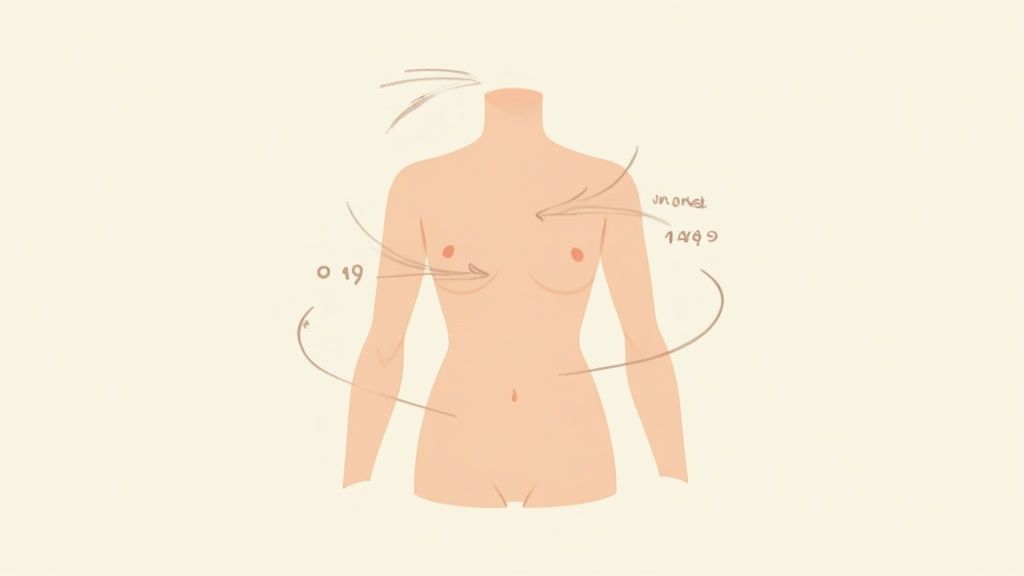
This isn’t just about relaxation; it’s a high-performance tool. Navy SEALs famously use box breathing to maintain calm and focus during life-or-death situations. In the corporate world, Microsoft has incorporated Dr. Andrew Weil’s 4-7-8 breathing into employee wellness programs to help teams manage pressure. The applications are practical across industries, from call center employees using quick breathing cycles between difficult calls to emergency room staff using them to decompress between patients.
How to Implement Deep Breathing at Work
Integrating these powerful workplace stress management techniques is easy and can be done anywhere, even at your desk, without anyone noticing.
- Practice 4-7-8 Breathing: When you feel anxiety rising, try the method popularized by Dr. Andrew Weil. Inhale quietly through your nose for 4 seconds, hold your breath for 7 seconds, and then exhale audibly through your mouth for 8 seconds. Repeat this cycle 3-4 times to feel an immediate calming effect.
- Use Box Breathing Before Big Moments: Before an important presentation or a difficult conversation, stabilize your nerves with box breathing. Inhale for a count of four, hold for four, exhale for four, and hold again for four. This rhythmic pattern is excellent for grounding your energy.
- Focus on Your Diaphragm: Many people breathe shallowly from their chest, especially when stressed. Place one hand on your chest and the other on your belly. As you inhale, focus on making your belly rise instead of your chest. This ensures a deeper, more relaxing breath.
- Set Daily Reminders: Use your phone or calendar to set three daily reminders to simply stop and take five deep, intentional breaths. This builds a consistent habit of resetting your nervous system throughout the day.
- Transition with Your Breath: Use your commute to consciously shift from “work mode” to “home mode.” Spend five minutes in your car or on the train focusing solely on slow, deep breathing to leave the day’s stressors behind.
3. Time Management and Prioritization
A constant feeling of being overwhelmed is a primary driver of workplace stress. Time management and prioritization techniques provide a systematic framework to regain control, transforming a chaotic workload into an organized, manageable plan. By structuring your tasks and focusing on what truly matters, you can reduce anxiety, prevent burnout, and create a clear path forward, making it one of the most effective workplace stress management techniques available.
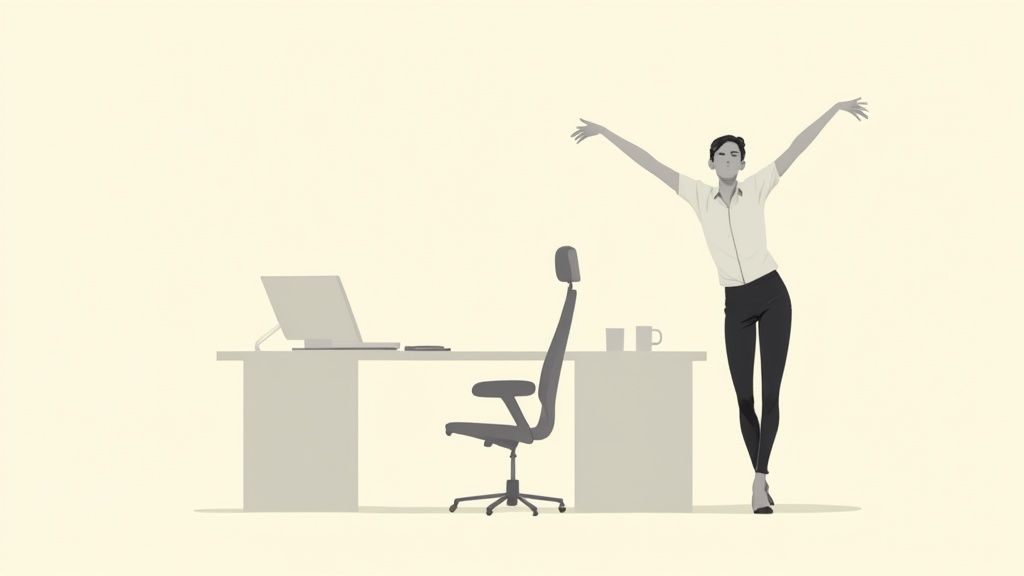
These methodologies are not just personal productivity hacks; they are foundational principles in major corporations. For instance, Atlassian uses frameworks like the Eisenhower Matrix to prioritize large-scale projects, and Buffer has famously adopted time blocking to ensure employees have dedicated periods for deep, uninterrupted work. This structured approach helps teams focus their energy where it has the most impact, reducing the stress associated with constant multitasking and shifting priorities.
How to Implement Time Management at Work
Integrating these strategies into your routine can create an immediate sense of order and reduce feelings of being swamped by your to-do list.
- Use the Eisenhower Matrix: Categorize your tasks into four quadrants: urgent and important (do it now), important but not urgent (schedule it), urgent but not important (delegate it), and neither (eliminate it). This helps you focus on high-value activities.
- Implement Time Blocking: Instead of working from a to-do list, assign specific blocks of time in your calendar for each task. This protects your time and ensures you make progress on important projects without constant interruptions.
- Try the Pomodoro Technique: Developed by Francesco Cirillo, this method involves working in focused 25-minute intervals separated by short 5-minute breaks. It’s excellent for maintaining concentration and preventing mental fatigue.
- Apply the 2-Minute Rule: Popularized by David Allen, if a task takes less than two minutes to complete, do it immediately. This prevents small, easy tasks from piling up and creating mental clutter.
- Create a “Done List”: At the end of the day, list everything you accomplished. This counteracts the feeling that you’re always behind and provides a tangible sense of progress and motivation.
4. Physical Exercise and Movement
Physical exercise and movement are fundamental workplace stress management techniques that combat the physiological effects of stress. Regular activity stimulates the production of endorphins, your brain’s natural mood elevators, while simultaneously reducing levels of stress hormones like cortisol. Integrating movement into your workday breaks the cycle of sedentary tension, improving both mental clarity and overall physical health.
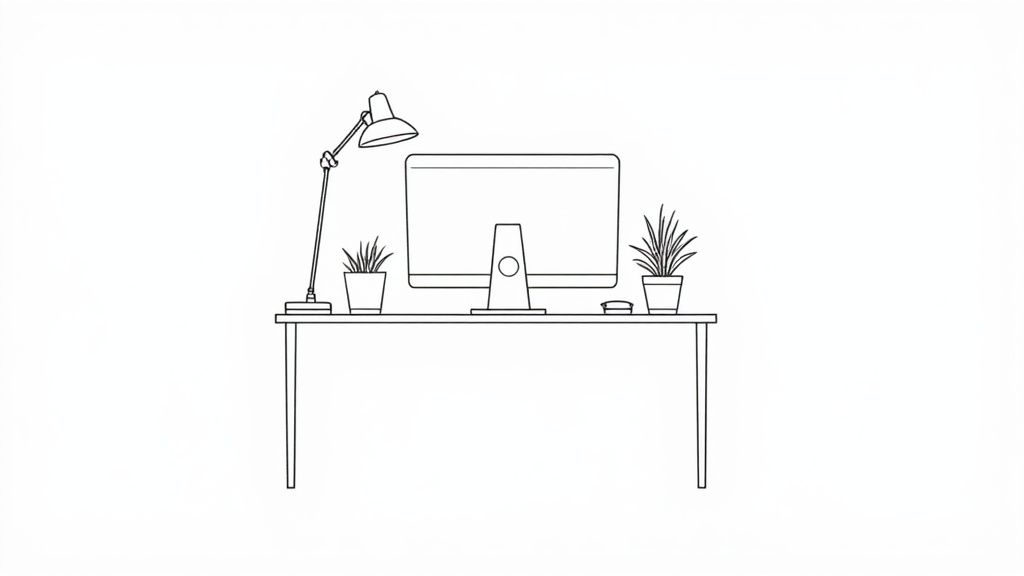
This approach is championed by leading companies that recognize the link between physical wellness and professional performance. Patagonia famously encourages “Let My People Go Surfing” breaks, while Johnson & Johnson’s wellness programs have reportedly saved the company over $250 million in healthcare costs. These examples show that prioritizing employee movement is not just a perk but a sound business strategy that boosts resilience and reduces burnout.
How to Implement Physical Exercise and Movement at Work
You don’t need an on-site gym to reap the benefits of physical activity. Small, consistent actions can make a significant difference in managing daily stress.
- Schedule Micro-Breaks: Set a reminder to get up every hour for just 5 minutes. Use this time to stretch, walk to the water cooler, or do a few simple desk exercises like neck rolls and shoulder shrugs.
- Embrace Walking Meetings: When a one-on-one discussion doesn’t require a screen, suggest taking the conversation on the move. Walking meetings can boost creative problem-solving and provide a welcome change of scenery.
- Utilize Your Lunch Break: Dedicate 20-30 minutes of your lunch break to a brisk walk, a quick jog, or a short bodyweight workout. This can reset your energy levels for the afternoon.
- Take the Active Route: Make simple choices that add more movement to your day. Use the stairs instead of the elevator, or park your car farther from the entrance to get in a few extra steps.
- Practice Desk-Based Stretches: Alleviate the physical strain of sitting by performing seated spinal twists, wrist stretches, and hamstring stretches right at your workstation. This helps prevent stiffness and tension buildup.
5. Progressive Muscle Relaxation (PMR)
Progressive Muscle Relaxation (PMR) is a deep relaxation technique based on the simple practice of tensing one muscle group at a time, followed by a period of relaxation. Developed by physician Edmund Jacobson, this method teaches you to recognize the physical sensation of tension and consciously release it, which in turn helps alleviate mental and emotional stress. As a workplace stress management technique, it directly addresses the physical toll of stress, like clenched jaws or tightened shoulders, which often goes unnoticed during a busy day.
The effectiveness of PMR is well-documented, particularly in high-stress professions. Healthcare workers often use it between shifts to decompress, and customer service representatives find it invaluable for releasing tension after difficult calls. The practice trains the body to achieve a state of calm on command, making it a powerful tool for managing acute stress in real-time.
How to Implement PMR at Work
You don’t need a quiet room or a yoga mat to practice PMR; many variations can be done discreetly right at your desk.
- Start with Major Muscle Groups: Begin by focusing on your feet and legs, then move up to your abdomen, hands, arms, and finally your shoulders, neck, and face. This systematic approach ensures a full-body release.
- Tense and Release: For each muscle group, inhale and tense the muscles for 5-7 seconds. The tension should be noticeable but not painful. Then, exhale and completely release the tension for 15-20 seconds, focusing on the feeling of deep relaxation.
- Focus on the Contrast: The key to PMR is noticing the significant difference between the feeling of tension and the feeling of relaxation. This awareness helps you identify and release stress more effectively throughout the day.
- Use Guided Audio: When you’re first learning, use a guided PMR recording from platforms like YouTube or apps such as Calm. An instructor can walk you through the process, ensuring you cover all muscle groups correctly.
- Try a “Mini” Session: For quick relief, perform a shortened version focusing only on your shoulders, neck, and face. Shrug your shoulders up to your ears, tense, and then release. This is perfect for before a big presentation or after a stressful meeting.
6. Cognitive Behavioral Techniques (CBT)
Cognitive Behavioral Techniques (CBT) are a set of powerful, evidence-based psychological strategies that help you identify and reframe the negative thought patterns and behaviors contributing to your stress. Instead of just treating the symptoms, CBT addresses the root cause: your interpretation of events. As a workplace stress management technique, it empowers you to break the cycle of automatic negative thoughts about deadlines, feedback, or coworker interactions, leading to healthier emotional responses and a more resilient mindset.
This approach is widely adopted in corporate wellness and resilience training. Tech companies often provide employees with CBT-based apps like Headspace for Work, while high-pressure sectors like banking and healthcare use cognitive restructuring principles in their stress management programs. IBM’s own resilience training, which incorporates CBT principles, has shown a measurable impact on employee well-being and performance.
How to Implement CBT Techniques at Work
You don’t need to be a psychologist to apply the core principles of CBT to your daily work life. These practical steps can help you manage stress more effectively.
- Identify Negative Thought Patterns: Start by recognizing common cognitive distortions. Are you catastrophizing a small mistake (“I’m going to get fired for this typo”) or engaging in all-or-nothing thinking (“If this project isn’t perfect, I’m a total failure”)?
- Challenge Your Thoughts: Once you spot a negative thought, question its validity. Ask yourself, “What is the evidence that this thought is true? What is the evidence that it isn’t?” This creates distance and perspective.
- Use the ABC Model: This simple framework helps deconstruct stressful reactions. Identify the Activating event (e.g., critical feedback), your Beliefs about it (e.g., “My boss thinks I’m incompetent”), and the Consequences of that belief (e.g., feeling anxious and demotivated). The key is realizing you can change your belief.
- Keep a Thought Diary: For a week, jot down stressful situations and the automatic thoughts that follow. This practice helps you uncover recurring patterns and triggers, making it easier to intervene and consciously choose a more balanced perspective.
- Practice Thought Replacement: Actively replace an irrational, stress-inducing thought with a more balanced and realistic one. Instead of “I can’t handle this workload,” try “This is a challenging workload, but I can break it down into manageable tasks and ask for help if needed.”
7. Work-Life Balance and Boundary Setting
Work-life balance is not about a perfect 50/50 split but about creating clear, intentional boundaries that protect your personal time from work-related demands. This approach is a critical workplace stress management technique because it prevents chronic stress and burnout by ensuring you have dedicated time to rest, recover, and engage in life outside of your job. It involves consciously separating your professional responsibilities from your personal life, which is essential for long-term mental and physical well-being.
This concept is supported by progressive corporate policies and national legislation. For example, France’s “right to disconnect” law prevents employers from requiring staff to check emails after hours. Similarly, Microsoft Japan’s trial of a 4-day work week resulted in a remarkable 40% boost in productivity, proving that less work time can lead to better, more focused results and reduced employee stress.
How to Implement Better Boundaries at Work
Setting effective boundaries requires clear communication and consistent habits. You can start small and build upon these practices to reclaim your personal time and reduce work-related stress intrusion.
- Define and Communicate Your Hours: Clearly establish your working hours and state them in your email signature or team chat status. Stick to these hours and avoid sending or responding to non-urgent messages outside of them.
- Create Physical and Digital Separation: If you work from home, have a dedicated workspace. Avoid working from your bedroom or living room. Similarly, consider using separate devices or user profiles for work to create a digital barrier.
- Disable After-Hours Notifications: One of the simplest yet most effective tips is to turn off all work-related notifications on your phone and computer once your workday is over. This prevents the constant pull of work from disrupting your personal time.
- Practice Saying ‘No’: Politely decline requests that fall outside your core responsibilities or work hours. You can offer alternative solutions, such as addressing the task during your next workday, without compromising your boundaries.
- Create a “Shutdown” Ritual: Develop a routine to signal the end of your workday. This could be as simple as clearing your desk, writing a to-do list for tomorrow, or going for a short walk. This ritual helps your brain transition from “work mode” to “personal mode.”
8. Environmental and Workspace Optimization
Environmental and workspace optimization is the practice of consciously designing your physical work area to reduce stress, minimize distractions, and promote well-being. Your immediate surroundings have a profound impact on your mood, focus, and overall stress levels. This technique involves making deliberate adjustments to elements like ergonomics, lighting, noise, and visual aesthetics to create a more supportive and comfortable environment.
This approach is a cornerstone of modern office design, popularized by companies like Google, which incorporates biophilic design (natural elements), and Etsy, which focuses on natural lighting and wellness rooms. Studies have shown that well-designed workspaces can reduce absenteeism and increase productivity. For example, research indicates that simply adding plants to an office can boost productivity by 15% and lower physiological stress.
How to Implement Workspace Optimization
Creating a stress-reducing workspace doesn’t require a major office overhaul. Small, intentional changes can make a significant difference in your daily experience.
- Prioritize Ergonomics: Adjust your monitor to be at eye level to prevent neck strain and position your chair so your feet are flat on the floor. An ergonomic setup prevents the physical discomfort that contributes to mental fatigue and stress.
- Optimize Lighting: Maximize natural light exposure by positioning your desk near a window if possible. Supplement it with adjustable task lighting to reduce eye strain, which can trigger headaches and irritability.
- Incorporate Natural Elements: Add a few low-maintenance plants to your desk. Greenery is proven to improve air quality, reduce stress, and create a calming visual atmosphere.
- Declutter and Organize: A cluttered space can lead to a cluttered mind. Spend five minutes at the end of each day organizing your desk, ensuring essentials are within easy reach. This simple habit minimizes distractions and creates a sense of control.
- Manage Noise: If you’re in a noisy environment, use noise-canceling headphones or a white noise machine to block out disruptive sounds. This helps you maintain focus and prevents the cognitive overload caused by constant interruptions.
Workplace Stress Management Techniques Comparison
| Method | Implementation Complexity 🔄 | Resource Requirements ⚡ | Expected Outcomes 📊 | Ideal Use Cases 💡 | Key Advantages ⭐ |
|---|---|---|---|---|---|
| Mindfulness Meditation | Moderate (requires consistency and quiet) | Minimal (no equipment, small space) | Reduced stress, improved focus & emotion regulation | Individuals/groups seeking long-term mental health | Proven cortisol reduction, anywhere practice |
| Deep Breathing Techniques | Low (simple to learn, immediate effect) | None | Instant stress relief, lowered heart rate | Quick stress relief at desk or meetings | Fast, discreet, multiple techniques |
| Time Management and Prioritization | Moderate to High (setup and maintenance needed) | Low to Moderate (tools/apps may help) | Increased productivity, reduced overwhelm | Task-heavy roles needing structure | Enhances focus, work-life boundaries |
| Physical Exercise and Movement | Moderate (time and scheduling needed) | Moderate (space, possible clothing) | Physical and mental stress relief, energy boost | Workplaces promoting wellness, group or solo | Endorphin release, muscle tension relief |
| Progressive Muscle Relaxation | Low to Moderate (quiet time needed, guided preferred) | None | Physical relaxation, improved sleep | Those with muscle tension, needing focused relaxation | Easy to learn, immediate tension relief |
| Cognitive Behavioral Techniques | High (time, effort, possibly professional guidance) | Low to Moderate (worksheets or apps) | Long-term stress management, thought pattern change | Individuals addressing root psychological causes | Addresses root causes, improves coping skills |
| Work-Life Balance & Boundary Setting | Moderate (discipline and communication required) | None | Burnout prevention, better personal life | High-demand jobs, remote work, boundary challenges | Prevents burnout, improves satisfaction |
| Environmental & Workspace Optimization | Moderate to High (may need investment) | Moderate to High (ergonomics, tech) | Reduced physical discomfort, enhanced mood & focus | Shared offices, high-stress environments | Physical comfort, productivity, mood boost |
Building Your Personal Stress Management Playbook
The journey through the landscape of workplace stress management techniques reveals a powerful truth: there is no single, one-size-fits-all solution. Managing stress effectively is not about finding a magic bullet, but rather about building a personalized and dynamic playbook of strategies tailored to your unique personality, role, and professional environment. The eight distinct methods we’ve explored, from the internal focus of mindfulness and deep breathing to the external structures of time management and workspace optimization, provide the foundational building blocks for this essential toolkit.
Think of each technique as a different tool for a different job. On a day filled with back-to-back meetings and overwhelming deadlines, a five-minute progressive muscle relaxation session at your desk might be the key to resetting your nervous system. When facing a looming project that triggers feelings of anxiety, cognitive behavioral techniques can help you reframe negative thought patterns into productive, realistic perspectives.
From Knowledge to Action: Your Next Steps
True mastery comes from consistent application, not just passive understanding. The goal is to move from knowing about these strategies to integrating them into the fabric of your workday. To begin this process, avoid the pressure of trying to implement everything at once.
- Select and Start Small: Choose just one or two techniques that resonate with you most strongly. Perhaps it’s the simplicity of the 4-7-8 breathing exercise or the tangible results of setting clear work-life boundaries.
- Schedule It In: Treat your stress management practice like any other important appointment. Block out 10 minutes on your calendar for a mid-day walk or set a recurring reminder to declutter your desk at the end of each day.
- Track and Reflect: Pay attention to how you feel after implementing a technique. Does a short meditation session leave you feeling more focused? Did establishing a hard stop time for your workday improve your evening relaxation? This feedback loop is crucial for refining your approach.
The Career-Defining Value of Resilience
Ultimately, learning to manage workplace stress is one of the most significant investments you can make in your long-term career success and personal well-being. It’s the skill that underpins everything else: your focus, your creativity, your collaborative abilities, and your capacity to lead. By proactively building your stress management playbook, you are not just coping with pressure; you are cultivating resilience.
This resilience empowers you to navigate challenges with greater clarity, prevent burnout before it takes hold, and maintain a sense of control and purpose in your professional life. It transforms stress from a debilitating obstacle into a manageable variable, allowing you to perform at your best and build a sustainable, fulfilling career. Remember, the most resilient professionals are not those who avoid stress, but those who have mastered the art of responding to it effectively.
Navigating career stress often starts with finding the right role in a supportive environment. Let Jobcamp streamline your search with AI-powered tools that match you to ideal opportunities, helping you build a less stressful and more fulfilling professional future. Explore your next career move at Jobcamp.

